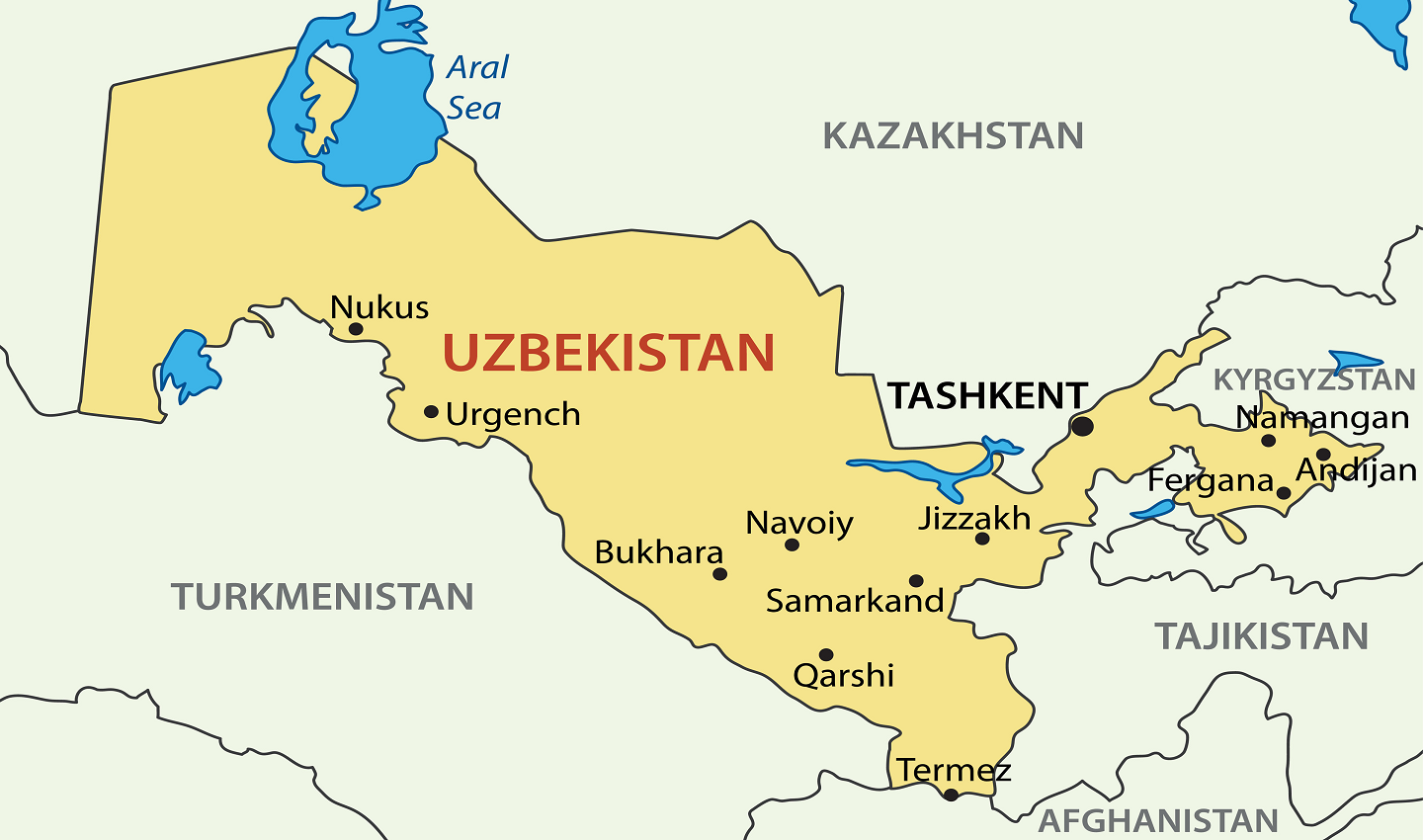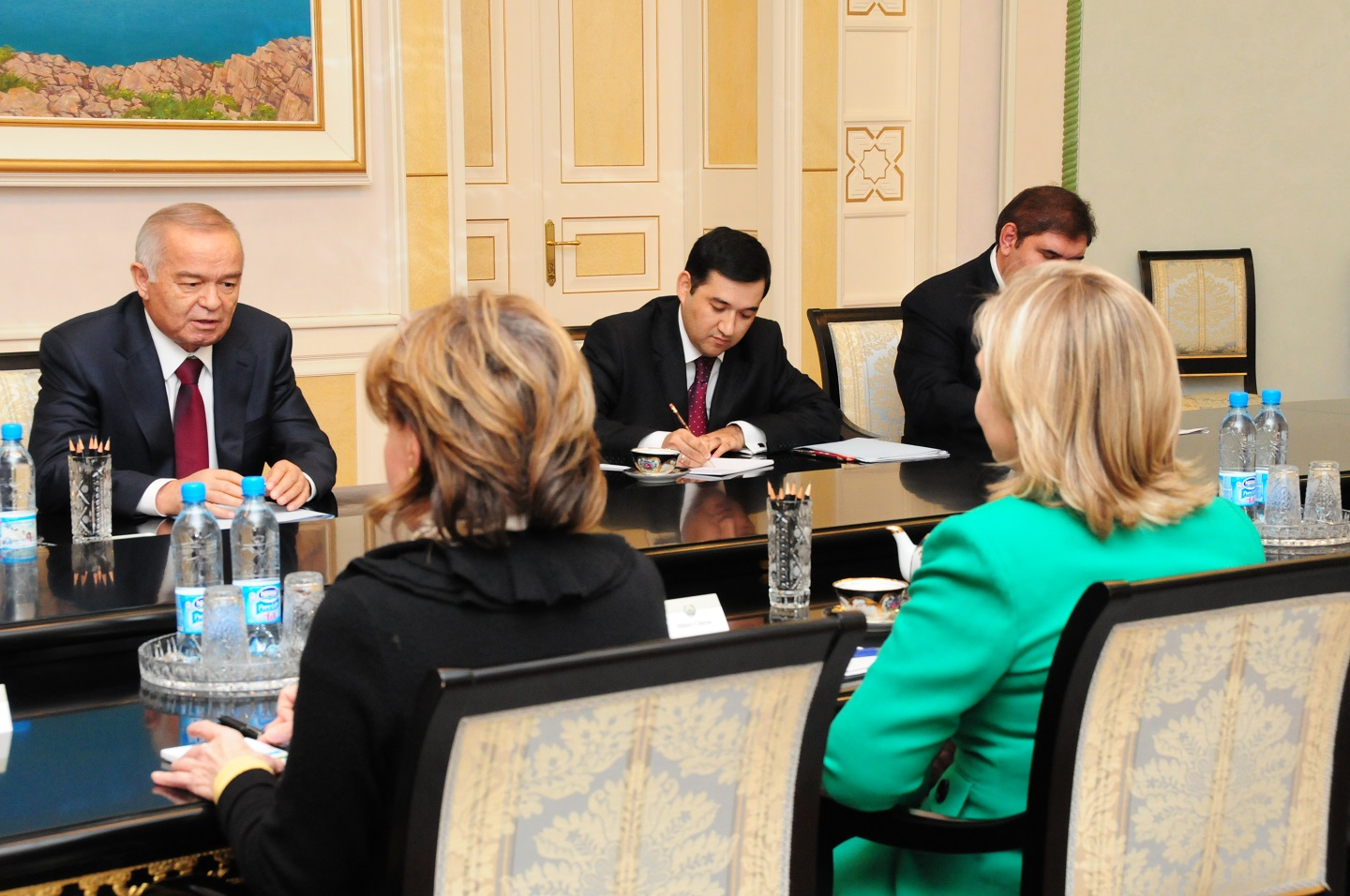
Uzbekistan Charts a New “Uzbek Path”
The announcement the Uzbek government has withdrawn from participation in the Eurasian Economic Community exemplifies the reliance upon what has come to be known as the “Uzbek Path.” Uzbekistan has a long tradition of independence in policy and orientation, having pursued economic and foreign policies often at odds with its Central Asian neighbors and with Russia. But the withdrawal from participation in the foremost economic cooperation organization in the former Soviet region, the Eurasian Economic Community (EAEC), is important because it represents a significant fissure in the solidarity among the former Soviet states so energetically promoted by the Russian government.
The EAEC Secretariat in Moscow was informed in mid-October 2008 by a diplomatic note from the Uzbek Ministry of Foreign Affairs of its decision to “suspend” participation in the EAEC. The Uzbek decision was not publicly discussed until the EAEC Secretariat acknowledged the diplomatic note on November 12, 2008. At the same time, a letter from Uzbek President Islam Karimov was sent to all the heads of state of the other EAEC countries—Belarus, Kazakhstan, Kyrgyzstan, Russia, and Tajikistan—informing them of Uzbekistan’s decision. Russian foreign officials were slow to acknowledge this unwelcome Uzbek decision. Russia in the years following the initiation of the EAEC agreement in October 2000, had invested a great deal of effort into sponsoring economic integration among the EAEC states. Russian Foreign Minister Sergei Lavrov in a November 17, 2008 press interview acknowledged the Uzbek move, noting that Russia would respect Uzbekistan’s right to make independent judgments but felt that the decision was not in Russia’s best interests.1
The Uzbek withdrawal from the EAEC is significant because Russia and the other member states have put great emphasis on the idea of re-establishing economic linkages severed during the period following the collapse of the USSR. The idea of creating an economic union grew out of the simple goal, common among all the members of the CIS, to establish and sustain a “single economic space” throughout the former Soviet region. The establishment of a single economic space meant different things to different people. In the eyes of some people, it represented the restoration of the Soviet era economic if not political relationships. In the eyes of others, it meant only the establishment of a new common region in which trade and commerce could flourish on the basis of market-driven supply and demand. These people saw the EAEC not as a revival of the USSR but as a preliminary step for integration into the world market and international trade organizations.

The EAEC members, Belarus, Kazakhstan, Kyrgyzstan, Russia, Tajikistan, and—after it joined the EAEC in January 2006, Uzbekistan—committed themselves to adopting common policies on customs, trade, labor, migration, education, currency exchange, interbank financial settlement, and infrastructure development. EAEC members adopted specific agreements designed to harmonize labor, monetary, customs, employment, tax, and investment laws and coordinate policies on a region-wide basis. The EAEC members embraced the idea of establishing a free trade area, while eliminating or at least regularizing internal tariffs. The EAEC announced its intention to create common external tariffs. EAEC members also began to expand the overall goal of economic cooperation to the idea of forming a single energy area, a single transport area, a gas marketing alliance, a single securities stock market and a new Ruble zone.
The EAEC may have been a grand economic design, but it was also the result of a great deal of very practical and down-to-earth political negotiating. After the Soviet collapse, the newly independent states emerged with very different institutional and resource endowments. The states adopted very different policies and assumed separate and often conflicting economic strategies. One of the most ambitious plans for bringing the post-Soviet states together to promote commerce was devised by Kazakhstan’s Nursultan Nazarbayev under the aegis of “Eurasian economic integration.” Nazarbayev, who had been a prominent Soviet political official and Communist Party Politburo member, as President of independent Kazakhstan began as early as 1994 to urge the other post-Soviet countries to adopt a unified idea of economic integration.
Nazarbayev’s Eurasian integration ideas were initially greeted in Kremlin circles with little enthusiasm. But the Kremlin approach gradually shifted when the Putin administration came to power in Russia. Qualms about Eurasian integration were put aside. Russia first accepted and then grew to be the leading sponsor of the idea of Eurasian economic integration. The Eurasian Economic Community was legally established in October 2000 in Astana, Kazakhstan’s capital, to institutionalize a framework of close economic cooperation. Russia became an enthusiastic supporter of further expanding multilateral ties by seeking to parallel economic cooperation with security linkages. Russia was instrumental in promoting the EAEC through investment and assuming the lion’s share of the EAEC’s administrative costs. At the same time, Russia began enthusiastically promoting the region’s most important security alliance, the Collective Security Treaty Organization (CSTO). The CSTO was established in October 2002 as a formalized and institutionalized version of the original Collective Security Treaty signed in 1992 in the wake of the Soviet collapse.
During the initial period of Russian sponsored regional integration, Uzbekistan stood aside. Uzbekistan was not a founding member of the EAEC and was not enthusiastic initially about the formation of the CSTO. Uzbekistan leaders from the early days of the Soviet collapse had always responded with alacrity to new cooperative initiatives but had also demonstrated very limited patience with agreements that failed to deliver results that satisfied Uzbekistan’s national interests. For instance, in the mid 1990s Uzbekistan was a founding member of both the Central Asian Union and the Central Asian Cooperation Organization. But Uzbekistan was also the first to walk away from these enterprises when they failed to address Uzbekistan’s interests with respect to problems of trade, labor migration, the energy-water nexus, and political extremism.
Uzbekistan’s separate path was rooted in its historical experience. When the Soviet Union began to disintegrate in 1990, Islam Karimov, then the first secretary of the Uzbek Communist Party, was elected president of Uzbekistan. Karimov was determined to make Uzbekistan a powerful and stable state, returning the Uzbeks to their traditions of the past. However, insecurity dogged the new Uzbek state, particularly after the growth of religious extremism in Afghanistan began to fuel an anti-Karimov insurgency. President Karimov called for international cooperation in Afghanistan, sharply criticizing the international community for its inability to see the dangers looming in the region. As the situation deteriorated in the mid 1990s, Karimov was still not willing to compromise Uzbek sovereignty and specifically ruled out the idea of permitting Russian forces to use bases on Uzbek territory to launch strikes against the Taliban regime in Afghanistan. The terrorist attacks against the United States in September 11, 2001, changed the situation. Washington’s more assertive foreign policy demonstrated the U.S. resolve to address issues of insecurity and instability throughout the sprawling Southwest Asian region. This changed the way Uzbekistan looked at the United States.
When Washington began seeking allies in Central Asia, it met with surprisingly rapid success. All of the countries in the region agreed to allow the United States to use their air space for military overflights. Karimov offered the use of the Soviet-era air facility located at Khanabad. The United States quickly swung into action. A mere three weeks after the events of 9/11, U.S. transport planes were landing at Khanabad and delivering materiel for Operation Enduring Freedom, the campaign to destroy al-Qaeda’s terrorist operations and remove the Taliban government in Afghanistan. Military-to-military relations between Uzbekistan and the U.S. expanded very quickly. Uzbekistan was seen widely in the region as “aligning” with the U.S. and western countries.

Despite good military relations between the two countries, broader diplomatic relations between the countries became problematic. The U.S. government assistance packages, which financed Uzbekistan-U.S. security cooperation programs, included requirements for progress in political and civil reform. Legislation signed into law in the U.S. on February 20, 2003 (P.L. 108-7) forbade some forms of assistance unless the Secretary of State determined and reported that Uzbekistan was making substantial progress in meeting its commitments to democratize and respect human rights. On July 13, 2004, U.S. State Department spokesman Richard Boucher announced that up to $18 million in military and economic aid would be withheld because of a “lack of progress on democratic reform and restrictions put on U.S. assistance partners on the ground.”2
Western criticism of Uzbekistan’s human rights record, Uzbekistan’s resistance to political and economic reform, and the political disorder that broke out in June 2005 in the eastern Uzbekistan city of Andijan changed the atmosphere of Uzbek relations with western states. Uzbek leaders informed the U.S. government that American troops were no longer welcome. U.S. troops withdrew from Uzbekistan and many of the U.S. financed assistance programs were brought to a close. At the same time that western influence was receding, it appeared to be replaced by an upsurge in relations with Russia. Uzbek and Russian officials concluded numerous high profile commercial deals and initiated cultural exchanges. Many observers concluded that the Uzbek government’s expulsion of U.S. military forces from the Khanabad airbase was a manifestation of Uzbekistan’s return to its initial post-Soviet orientation and a restoration of a pro-Russian political alignment. In May 2005, Uzbekistan officially withdrew from GUAM, a westernleaning regional economic and security cooperation organization. In January 2006, Uzbekistan joined the EAEC. In October 2006, Uzbekistan became a member of the CSTO.
Eurasia’s new integration organizations address security and economic challenges in ways that paralleled the functions of existing international organizations, in some cases complementing them and in some cases conflicting with them. Eurasian cooperation activities grew in number and visibility, in terms of summits, meetings, conferences, communiqués, resolutions, decrees, and, of course, in terms of the sheer volume of normative acts, bureaucratic policies and provisions. But observers complained that despite all of the integration activities, there was a conspicuous absence of commensurate results. Dissatisfaction led to questions, which eventually led to objections.
Uzbek President Islam Karimov eventually became dissatisfied with the inability of the cooperation organizations to achieve their goals. Karimov, who along with Nursultan Nazarbayev, is one of the two longest serving political veterans of the Soviet and post-Soviet period, began proposing innovative approaches. Karimov announced a major initiative to support Afghanistan reconstruction in April 2008 when he stated at the Bucharest NATO conference that “Uzbekistan stands ready to discuss and sign with NATO the Agreement on providing for corridor and transit through its territory to deliver the nonmilitary cargos through the border junction Termez-Khayraton, practically the sole railway connection with Afghanistan.”3 Attempting to forge yet another transnational cooperative undertaking, Karimov in May 2008 announced the idea of merging the CSTO and the Eurasian Economic Community in order to collectively work with Europe on security cooperation throughout the region.4 But Karimov’s initiatives were overlooked or ignored by many Eurasian partners.
The Uzbek government’s decision to withdraw from participation in the EAEC raises as many questions regarding the resilience of traditional political alignments in the post-Soviet region as it does regarding the orientation of the “Uzbek path” ahead. While many analysts in the post-Soviet regions continue to look at political dynamics in terms of the legacy of the Soviet past and the requirements of the restoration of traditional security and economic linkages, the Uzbek leadership’s bold suspension of participation in the EAEC in October 2008 is an indication of the growing willingness to look at tomorrow’s policy challenges in innovative terms. In this context, Uzbek president Islam Karimov’s innovative “6+3 Initiative” calls for a dramatically different approach of aligning European, Russian and U.S. interests with those of the Central Asian states in addressing normalization in Afghanistan —one of the international community’s the most urgent challenges.
Uzbekistan’s suspension of its EAEC membership is apt to cause consternation among the more legalistically inclined of the Russian policy establishment, given that it appears to be a move whose implications are undefined. The EAEC is a voluntary organization. The EAEC charter specifies provisions for withdrawal. Members are free to withdraw with a year’s notice and with assurances of fulfilling financial and other commitments of membership. The procedure and consequences of “suspending” participation is not defined in the charter. The idea of suspending treaty compliance is not without precedent (given that Russia in July 2007 “suspended” its participation in the Conventional Forces in Europe Treaty). But the idea of suspending participation in an international organization does imply some uncharted territory in international law. Uzbekistan’s decision to withdraw from the EAEC marks a turning point in expectations regarding alliance relations in Eurasia. Observers have raised the question whether Uzbekistan’s withdrawal from the CSTO cannot be far behind.
Eurasian inter-state cooperation is obviously in an important phase of redesign. Over the past two decades, the principal policy concerns throughout the Eurasian region focused on post-communist transition and managing the consequences of the disintegration of the USSR. It is increasingly clear that the importance of these issues has now become far outpaced with the forward-looking challenges relating to greater competition over market position (particularly with respect to energy and minerals), a rapidly changing security terrain (particularly with respect to the risks to Central Asia from Afghanistan’s Taliban insurgency), new challenges that are just over the horizon (particularly ballistic weapons technology, and the nuclear balance given Iran’s uranium enrichment program), and a new set of environmental challenges (particularly relating to population change, water and electricity supplies, and public health conditions).
The EAEC’s economic goals were closely paralleled with political objectives, particularly those of Russia. After having been diminished for more than a decade following the collapse of the USSR, Russia has begun to reemerge as an important and influential actor on the world stage thanks to soaring oil and natural gas prices.
Despite the fact that the EAEC was a multilateral institution, Russia has begun to see the EAEC as an instrument for Russian foreign policy objectives. The post-September 2001 period witnessed an increasingly assertive and self-confident foreign policy directed by an activist president, managed by a cadre of professionally schooled “intellicrats,” and supported by a pantheon of well-ensconced and politically resourceful oligarchs. As Russian President Vladimir Putin changed hats, switching to the role of Prime Minister and bringing in likeminded President Dmitri Medvedev, Russia’s foreign policy strategic agenda expanded significantly.
The Russo-Georgian 5-Day War was the first illustration of a grand Russian strategy, which anticipated Russia’s assumption of a dominant position throughout the post-Soviet space. Russia sought to use its ability to corner energy supplies as an instrument for creating a special sphere of Russian influence while projecting its new image as a state willing and able to employ armed force. Russia sought to divide opposition by forcing a wedge into Western-oriented coalitions. Dmitry Medvedev, in his “Berlin Initiative” announced in June 2008 called on creating a new international security cooperation organization, which would supplant the existing international organizations.
While many analysts in the post-Soviet regions continue to look at political dynamics in terms of the legacy of the Soviet past and the requirements of the restoration of traditional security and economic linkages, the Uzbek leadership’s bold suspension of participation in the EAEC is an indication of the growing willingness to look at tomorrow’s policy challenges in innovative terms. It is a demonstration that Uzbekistan, in the long run, can be expected to consistently fix its compass on one particular heading, the “Uzbek path.”
For Academic Citation
Gregory Gleason, “Uzbekistan Charts a New ‘Uzbek Path,’ ” Marshall Center Security Insight, no. 3, November 2008, https://www.marshallcenter.org/en/publications/security-insights/uzbekistan-charts-new-uzbek-path-0.
Notes
1 Vremya Novostei, (17 November 2008), 2020, http://www.vremya.ru/2008/212/5/217155.html.
2 Nichol, Jim. “Central Asia: Regional Developments and Implications for U.S. Interests,” CRS Report for Congress, accessed November 2008, p. 34, http:// assets.open crs.com/rpts/RL30294_20080129.pdf.
3 Address by President Islam Karimov at the NATO Summit, accessed November 2008, http://mfa.uz/eng/press_and_media_service/news_and_events/040408e_2.mgr.
4 “Тashkent brosaet perchatku NATO” Nezavizamaya gazeta (11 June 2008) http://www.ng.ru/cis/2008-06-11/10_tashkent.html.
About the Author
The George C. Marshall European Center for Security Studies in Garmisch-Partenkirchen, Germany, a German-American partnership, is committed to creating and enhancing worldwide networks to address global and regional security challenges. The Marshall Center offers fifteen resident programs designed to promote peaceful, whole of government approaches to address today’s most pressing security challenges. Since its creation in 1992, the Marshall Center’s alumni network has grown to include over 13,715 professionals from 155 countries. More information on the Marshall Center can be found online at www.marshallcenter.org.
The articles in the Security Insights series reflect the views of the authors and are not necessarily the official policy of the United States, Germany, or any other governments.